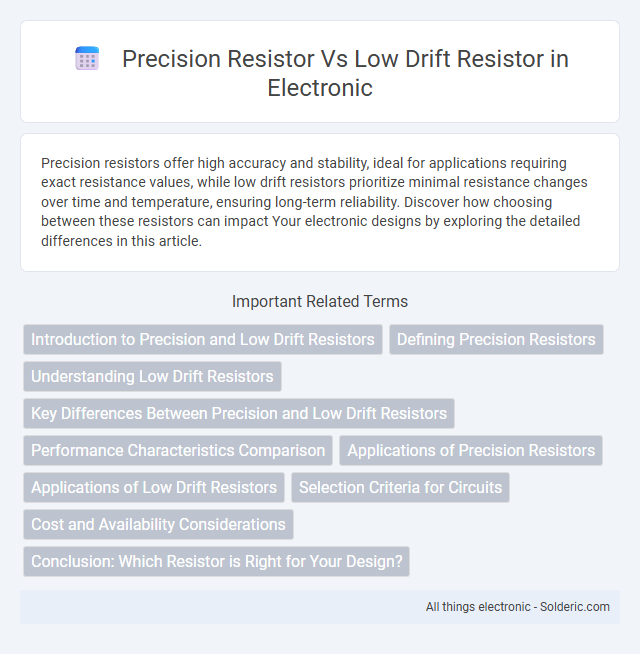Precision resistors offer high accuracy and stability, ideal for applications requiring exact resistance values, while low drift resistors prioritize minimal resistance changes over time and temperature, ensuring long-term reliability. Discover how choosing between these resistors can impact Your electronic designs by exploring the detailed differences in this article.
Comparison Table
| Feature | Precision Resistor | Low Drift Resistor |
|---|---|---|
| Tolerance | +-0.1% to +-0.01% | Typically +-0.05% to +-0.1% |
| Temperature Coefficient (TCR) | 5 to 50 ppm/degC | 1 to 5 ppm/degC (very low drift) |
| Stability | Good stability over time | Exceptional stability with minimal resistance change |
| Applications | Measurement, calibration, and precision circuits | High precision equipment, sensor interfaces, medical devices |
| Cost | Moderate | Higher due to advanced materials |
Introduction to Precision and Low Drift Resistors
Precision resistors offer highly accurate resistance with tight tolerance levels, essential for applications requiring exact voltage and current control. Low drift resistors maintain stable resistance values over time and temperature variations, ensuring reliability in long-term and temperature-sensitive environments. Your choice between these resistors depends on whether accuracy or stability under changing conditions is the primary concern.
Defining Precision Resistors
Precision resistors are electronic components characterized by their highly accurate resistance values, typically within +-0.1% tolerance or better, ensuring consistent performance in sensitive circuits. These resistors are designed with materials and manufacturing processes that minimize resistance variance under temperature changes, vibrations, and electrical stress. Your choice of precision resistors guarantees reliable and stable circuit behavior where exact resistance is crucial.
Understanding Low Drift Resistors
Low drift resistors maintain stable resistance values over a wide temperature range, minimizing variations that can affect circuit accuracy. These resistors typically use specialized materials and construction techniques to reduce temperature coefficient of resistance (TCR), enhancing long-term reliability and precision in sensitive applications. Understanding low drift resistors helps you select components that ensure consistent performance in measurement and control systems.
Key Differences Between Precision and Low Drift Resistors
Precision resistors are designed for high accuracy with tight tolerance levels typically around +-0.1% or better, ensuring consistent resistance values for precise circuit performance. Low drift resistors emphasize long-term stability by minimizing resistance changes due to temperature variations and aging, often featuring temperature coefficients as low as +-5 ppm/degC. While precision resistors prioritize exact initial values, low drift resistors focus on maintaining those values over time under varying environmental conditions.
Performance Characteristics Comparison
Precision resistors offer high accuracy with tolerance levels often within +-0.1% and exhibit low temperature coefficients around 5 to 25 ppm/degC, ensuring stable resistance across varying temperatures. Low drift resistors emphasize long-term stability, maintaining resistance values with minimal change over thousands of hours, typically showing drift rates less than 10 ppm/year. While precision resistors excel in immediate accuracy and low noise, low drift resistors outperform in long-term reliability and thermal stability for critical measurement applications.
Applications of Precision Resistors
Precision resistors are essential in applications requiring exact resistance values with minimal tolerance, such as in measurement instruments, calibration devices, and high-accuracy analog circuits. These resistors provide stable performance under varying environmental conditions, making them ideal for sensor interfaces and medical equipment. Your designs benefit significantly from precision resistors when accuracy and reliability are critical for proper functionality.
Applications of Low Drift Resistors
Low drift resistors are essential in high-accuracy measurement systems, such as precision instrumentation and medical devices, where minimal resistance change over time and temperature ensures stable performance. These resistors excel in applications demanding exceptional thermal stability and low noise, including aerospace avionics and audio equipment. Their ability to maintain precise resistance values under varying environmental conditions makes them ideal for feedback loops and sensor signal conditioning circuits.
Selection Criteria for Circuits
Precision resistors offer tight tolerance and stability, making them ideal for applications requiring exact resistance values and minimal variation, such as measurement and instrumentation circuits. Low drift resistors excel in environments with fluctuating temperatures or long-term use, maintaining resistance accuracy by minimizing performance changes over time. Your circuit design should prioritize precision resistors when accuracy is paramount, while low drift resistors suit applications demanding stability under environmental stress.
Cost and Availability Considerations
Precision resistors typically have higher costs due to tighter tolerance specifications and lower temperature coefficients, making them suitable for applications requiring high accuracy. Low drift resistors, designed to maintain resistance stability over time and temperature changes, often come at a premium price and may have limited availability depending on the specific drift characteristics needed. Both resistor types can vary in availability based on brands and suppliers, with precision resistors generally more widely stocked due to broader usage in precision electronics.
Conclusion: Which Resistor is Right for Your Design?
Precision resistors offer high accuracy with tightly controlled resistance values, making them ideal for applications requiring exact measurements and stable performance under varying conditions. Low drift resistors excel in environments where minimal resistance change over time and temperature is critical, ensuring long-term reliability in sensitive circuits. Your choice depends on whether accuracy or stability under thermal stress is the priority for your design.
Precision resistor vs low drift resistor Infographic

 solderic.com
solderic.com